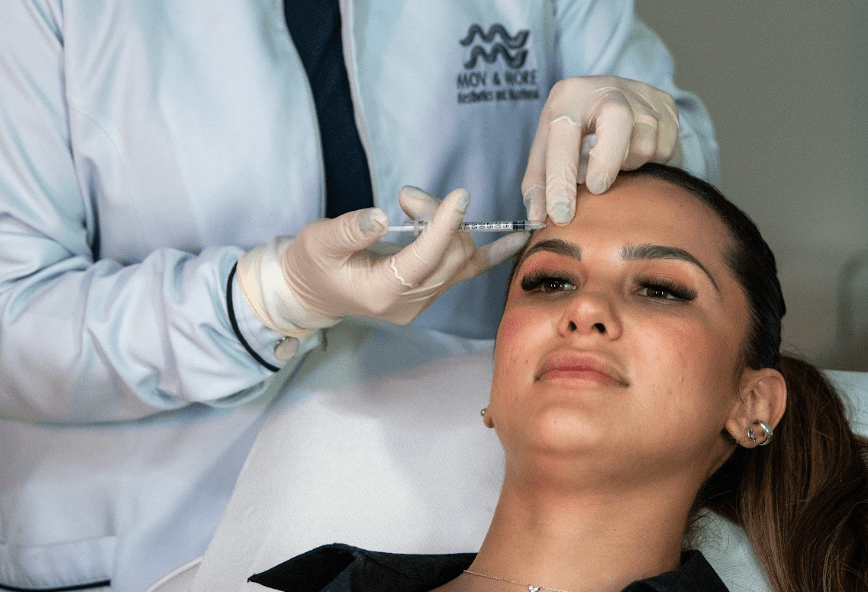Different skin types require different care routines, and understanding your skin type is the key step to properly care for your skin and achieve incredible results and reduce oily skin.
Despite being the one of the most common skin types, there are numerous misconceptions in caring for oily skin that can intensify various facial issues such as blackheads, acne, and excess shine.
While all these problems are typical, there is indeed control for oiliness, and in this article, you will find everything about oily skin—how to recognise it, the causes, and finally, the 6 tips that MovMore Clinic has curated for you on how to look after oily skin.
How do you recognise oily skin?
Not everyone is aware that they fall into the category of oily skin because the manifestation is not identical for everyone. In oily skin, increased sebum production manifests across the entire face due to the skin's excessive oil production. The pores, small openings through which sebum is drained, become enlarged and highly visible, leading to blackheads and, in cases of inflammation, acne.
Moreover, the scalp is also affected, with hair easily becoming oily. In addition, oily skin is characterised by:
- Having a shinier appearance than other skin types, especially on the forehead but not limited to that area;
- Intense oiliness across the entire face;
- Enlarged and visible pores;
- A higher tendency to develop acne—blackheads and pimples, even in adulthood.
What Are the Causes of Oily Skin?
There isn't a single answer to this question. Excessive sebum production can result from various factors. The primary reasons are endogenous, meaning they depend on internal causes such as genetics or hormonal imbalances (especially during adolescence).
External factors also play a role, including the use of unsuitable skincare products, lack of hygiene, fatty diets.
How to look after oily skin?
1. Don't wash your face too many times a day
If you have oily skin, there's no need to wash your face several times a day. Instead, use cleansers or other products specifically designed for your skin type, formulated with more surfactants than those for dry or normal skin. However, these products shouldn't affect the skin, removing its natural oils excessively.
2. Use dry-touch sunscreen
Sunscreen is an essential requirement for all skin types. For individuals with oily skin, paying extra attention to this practice is crucial. Opt for the best face sunscreen for oily skin—a dry-touch formula that effectively aids in controlling oiliness.
3. Avoid touching your face
This habit can be quite harmful to the skin, especially if it is oily once you can spread dirt, oil, and bacteria from your hands to your face. Hands, in addition to being in contact with various impurities all the time, typically produce a significant amount of sweat.
Those who have the habit of frequently touching their faces end up "transferring" impurities and more oil to the region. Only touch your face when you're cleansing, moisturising, or applying sunscreen or makeup, and make sure your hands are clean first.
4. Use products suitable for your skin type
Opt for products tailored to your skin type, from cleansers to moisturisers and sunscreen. A visit to a dermatologist can provide personalised recommendations for the right products. Avoid using too many products at once; by using a minimal yet essential routine, you can better understand which products may be adversely affecting your skin. If you notice any issues, suspend their use immediately.
5. Don’t sleep in your makeup
Always remove all makeup before going to sleep.. Sleeping with makeup impedes the skin's ability to breathe, leading to enlarged pores, an increased likelihood of blackheads and pimples, and elevated oiliness.
6. Hydrate your skin with a gel/oil-free moisturiser
Contrary to popular belief, oily skin also requires hydration. Moisturising should follow every instance of facial cleansing.
Various formulations are available in the market; opt for lightweight, oil-free, or water-based moisturisers.
Consult with a skincare professional to evaluate and test the facial moisturiser that best suits your skin.
What are the best facial treatments for oily skin?
In addition to the tips provided in this post, explore the facial treatments for oily skin at Movmore Clinic in Dublin. Our extensive selection of treatments aims to minimise oily-prone skin, seamlessly integrating into your skincare routine. Our key oily skin treatments include:
Deep Pore Cleansing Facial is designed to effectively address excess oil and impurities, leaving your skin refreshed and revitalised.
Carbon Laser Peel offers a superficial treatment targeting concerns such as acne, enlarged pores, oily skin, and uneven skin tone.
At MovMore Clinic, trust our skilled professionals to enhance the health and appearance of your skin. Encourage yourself to invest in consistent care, and count on MovMore Clinic for personalised and professional skincare treatments. Your journey to radiant, balanced skin begins here.





